How to open an interior door without a key: the best ways to open a slammed door
Suddenly you find yourself in front of a slammed door to the next room and realize that you can’t open it? And it doesn’t matter what caused this - a draft, the tricks of a beloved pet, or your own negligence. The first thought in my head is how to open an interior door without a key.
Agree, even if you have never been in such a situation, no one is immune from this, and knowledge of how to quickly open an interior door will never be superfluous. In our material we will look at effective ways to open interior doors in a variety of cases.
There can be many situations with a slammed door, and the locking mechanisms are also different. Therefore, the solutions are significantly different from each other. We hope that the knowledge gained will be useful and you will not have to knock down doors or call the Ministry of Emergency Situations - everything can be done quickly and easily with your own hands.
The content of the article:
Methods for opening doors without a key
The method of opening an interior door depends on many factors. Of course, you can simply knock out the door leaf and quickly solve the problem. We will consider this method, but at the very end, as a radical method that requires an immediate solution to the problem.
Now let's get acquainted with the various factors, types of locks and possible methods of opening doors.How can you choose the best method and which methods are the most effective?
The choice is influenced by the following factors:
- lock type;
- reason for latching: sunken latch tongue, failure of the push-button mechanism, key left in the keyhole;
- finding a relatively closed door;
- having a time limit to solve the problem.
Let's consider ways to open an interior door, taking into account the above factors and try to offer optimal ways to solve the problem for a variety of situations.
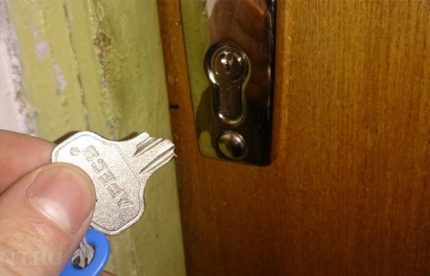
Option #1 - Latch Offset
Most often, interior doors are equipped with a rotary or push-type handle. Convenient and simple solution. It is the most common. But the handles can be completely different, and the principles of operation can differ significantly.
When choosing an opening method, the location relative to the door plays a role. In addition, opening can also be complicated by the fact that there is a key left in the keyhole, which can be a stopper. Let's look at each case in more detail.
Without a key in the keyhole
Latching the handle is the easiest option in terms of opening. But here there are some small nuances: it all depends on which side the latch is located or which side of the door you are on.
There is always a minimum gap between the frame and the door leaf.
If you are on the side of the beveled part of the latch, then the easiest way to solve the problem is to simply insert any thin object into the gap:
- scissors;
- nail file;
- screwdriver;
- plastic bank card.
You just need to tug the door a little and gradually press the latch with the selected object. Usually 20-30 seconds is enough for the door to open.
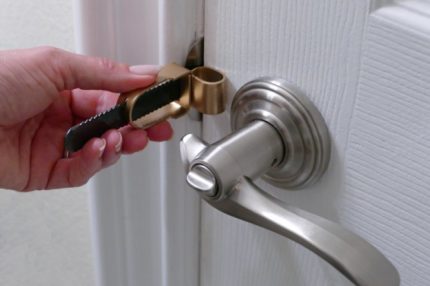
If the beveled part of the latch is on the opposite side, you will have to tinker a little longer. All actions are performed in the same order, with the only difference being that the latch must be moved gradually, in several stages.
A bank card will not work for this; you only need a hard object. After each shift of the latch, you need to press it with the door and move the object by 1-2 mm - as far as the gap is sufficient. In this way, the latch can be completely retracted in a few times.
With the key in the keyhole
If we are talking about a simple handle and not a complex lock, then you can try to push the key out of the keyhole using a thin, sharp object - an unbent paper clip or open scissors from a manicure set. But this method is only suitable if we are talking about the latch, and not about problems with the lock.
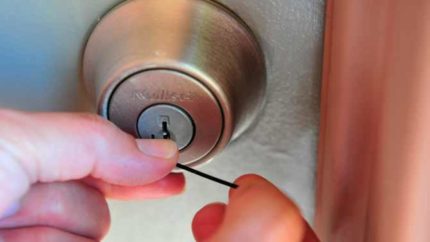
Some locks have a plug that looks like a button. In this case, you can grab it with pliers and turn it, the latch is guaranteed to move.
Option #2 - door with a lock
There are cases when cylinder or lever locking mechanisms are installed on interior doors.Here it’s a little more complicated, there’s even a chance that you won’t be able to deal with such a castle easily.
But there are still several ways. If time permits, you can try everything and try to open the lock with minimal damage. It may seem primitive, but sometimes it works. It is enough just to give the door a good tug, and in simple locks the bolts bounce off by themselves. But this is more of a happy accident.
Option #3 - through the lock cylinder
If the lock is not new, but already designed, then you can try to use a similar key or use a thin, sharp object as a master key. Sometimes this works and it is possible to turn the key or master key in the lock, thereby moving the latch or bolts.
If the method with a key and a master key does not bring results, then you can try to remove the lock. To do this, you need to unscrew all visible screws, remove the trim strips and the handle. Such actions will open access to the locking mechanism.
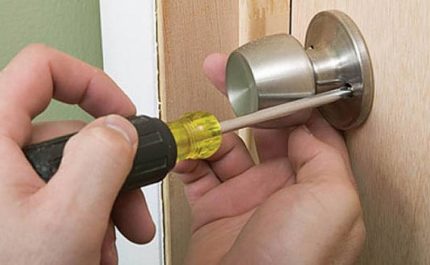
You need to insert a lever into the opened hole; a screwdriver is best for this. You will have to apply some force if the lock is not equipped with a lock. Often it is possible to turn it and thereby return the crossbars to their place.
Radical methods or brute force methods
If all the tried methods do not bring the desired results, then all that remains is to break the lock or dismantle the door. Here you need to proceed from the specific situation and be guided by what will cause the least damage.
First you need to carefully examine the door hinges, evaluate their design and installation method. You are already familiar with the gap between the frame and the door leaf, as you have previously tried to move the latch or move the bolts.
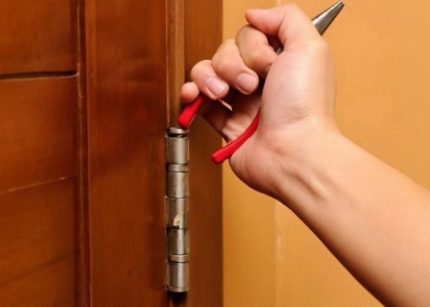
In the end, it may be necessary to evaluate the strength of the structure; it is possible that brute force will be able to bring the desired result.
Cutting latches and bolts
If there is a sufficient gap between the door leaf and the frame, you can try to cut off the sunken tongue or crossbars. You need to work carefully and use an angle grinder. We recommend that you read rules for working with an angle grinder.
If you manage to do everything as accurately as possible, then the paint will be only slightly damaged by the action of sparks.
If the gap does not allow cutting off the crossbars, then you need to pay attention to the door hinges. The method of removing the door leaf from the awnings depends on their design. If card-type hinges or similar ones are used, then you can simply unscrew the screws, release one side of the door leaf and dismantle it.
Removing door hinges
It is ideal if you can limit yourself to simple disassembly, but this is simply impossible if hidden hinges are used. In this case, there is also nothing left to do but cut the loops using a grinding machine.
You need to watch on site how the loop is installed. You can cut the upper and lower loops along the entire length of the plate. If the hinges protrude even a little, you can stick a sheet of paper on the door and cut the hinge cylinders. This way the decorative coating of the door leaf will be preserved.
How to knock down a door?
There is another simple and effective way to use brute force. If the door opens inward, you can simply knock it down with a sharp blow. Of course, the door frame will be damaged, but there are many methods for restoring it.
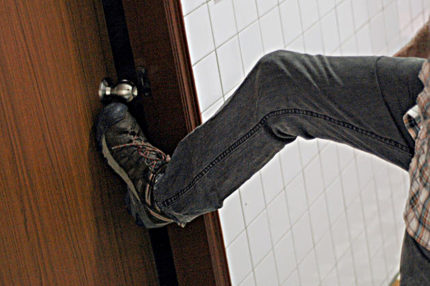
Usually the door is kicked in. This causes the least amount of damage. You should not use impact tools such as a hammer; they, of course, will cope with the task, but may lead to the fact that you simply have to change the door leaf.
Measures to prevent such a situation
Situations where the lock breaks can be avoided. If not guaranteed and 100%, then certainly minimized.
Yes, there are a number of other points that can be taken into account when installing a door lock in order to facilitate its dismantling:
- Install locks with emergency opening capabilities.
- Avoid using complex mechanisms unless absolutely necessary.
- A spare set of keys can be placed in a drawer in the kitchen or hallway.
- Regular lubrication of moving parts (it is better to use a penetrating lubricant).
- Timely replacement of locks that have begun to jam.
- Leave a gap between the door leaf and the frame as a last resort - in case you still have to cut off the bolts or latch tongue.
These simple methods will help you avoid an unpleasant situation with a slammed door, a broken lock, or will be useful in solving the problem that has arisen.
Not only can the interior door be closed, but sometimes you just can’t deal with a blocked washing machine door. How open the washing machine read our next article.
Conclusions and useful video on the topic
5 ways to open an interior door without a key
We looked at several ways to help deal with a slammed interior door without using a key. Any closed door requires your own approach; you should always start with an inspection, taking into account the complexity of the mechanism, the presence of gaps, the strength of the structure and the time you have.
It is best to start with more gentle methods; it is not a fact that the efforts will be crowned with success, but it is always worth a try. Moreover, the simplest methods do not require any tools or skills.
We hope that our advice will be useful and, if you find yourself in a situation where you have to open a door without a key, you will cope with the task.
Have you ever been in a situation where you had to open a door without keys and managed to overcome the problem? Share your experience with our readers using the form below the article.



